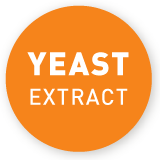Glutamate occurs in foodstuffs in two different forms. On the one hand, it occurs in the so-called bound form. Here the glutamic acid is linked with other amino acids and so is therefore bound in proteins. In this form the glutamate has only very little taste. On the other hand, it occurs in the so-called free form in plant and animal tissues – this version is the one that makes the taste seem especially aromatic.
Foodstuffs with a high proportion of glutamate such as cheese and ripe tomatoes enjoy a high consumer acceptance because of their intensive tastes. The proportion of free glutamate in plant or animal foodstuffs increases during cooking, fermentation or ripening processes. So it is not surprising that such preparation or refining practices are firmly established in many food cultures – examples for this range from the traditional fermentation of soy sauce over the cooking of a meat stock to the maturing of a Spanish Serrano ham.
The expert Prof. Dr. Thomas Vilgis of the Max-Planck-Institute for Polymer Research in Mainz puts it more strongly and says: “If you were to analyse the content of free glutamic acid in reduced stocks, broth, ‘glace’ and sauces, your result would be: They are all-naturals glutamic acid bombs!”



